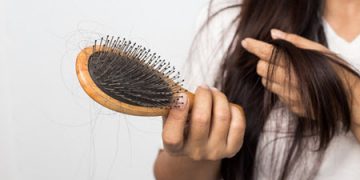Iron deficiency and hair loss
Today, the problem of iron deficiency or iron deficiency anemia is considered a world problem (more than 2 billion people), especially women of childbearing age and children. And it is iron deficiency that is the most common cause of hair loss in women, this is confirmed in their articles by American and French experts. But this does not mean that everyone has hair loss against the background of iron deficiency, there is still a whole series causes of hair loss, although for example, there are cases when androgenic alopecia can increase, with latent iron deficiency, then androgenic and diffuse hair loss is already combined. Iron deficiency is thought to reduce cell division of the hair follicle... Iron deficiency is an aggravating factor in all types of alopecia, especially androgenetic.
If the nutrition is correct, balanced and regular, then our body receives about 10-15 mg of iron per day, but only 1-2 mg is absorbed.
With iron deficiency, not only hair loss is manifested, the first symptoms can be dryness, brittleness and a decrease in the diameter of the hair, that is, the very quality of the hair changes.
How to determine if there is an iron deficiency
The assessment of the iron content in the body is based on the results of blood, urine and hair tests.
Standard indicators of iron metabolism in the body:
- hemoglobin - the norm for women is 125g / liter and above, for men it is 135g / liter and above.
- serum iron - normally not less than 12.5 μmol / liter.
- total or latent serum iron-binding capacity (TIBC or LVCC) - the amount of iron that can bind to transferrin. The norm is 30.6 - 84.6 μmol / liter.
- ferritin - a protein that reflects the body's iron stores. The norm is 20 - 250 mcg / liter.
Ferritin less than 40 mcg / liter - latent iron deficiency. Less than 70 mcg / liter - Trial hair loss treatment is acceptable!
The minimum screening kit required to exclude iron deficiency includes: a clinical blood test (Hb, ESR), serum iron, TIBS (LVSS), ferritin.
The main symptoms of iron deficiency in Iranism
- decreased immunity;
- atrophic gastritis;
- increased fatigue and weakness;
- decreased ability to work, fatigue
- tendency to heavy menstrual bleeding;
- increased cravings for certain foods (chocolate, carbonated drinks);
- perversion of taste (addiction to chalk, tooth powder);
- attracted by the smells of varnish, paint, gasoline, kerosene;
- shortness of breath and palpitations during normal physical activity;
- chilliness of the arms and legs;
- fragility and striation of nails.
If you notice one or more of the symptoms from this list, be sure to go to an appointment with your therapist, who will prescribe basic tests and examinations.
Anemia and hair loss
How is iron deficiency externally manifested? Hair - thinning, dryness, increased hair loss, loss of pigmentation. Nails - thinning, brittleness, cross striation. Skin - dryness, peeling, sometimes even itching.
Doctors say that a year after the iron deficiency in the body is restored, the hair will begin to regenerate and grow back.
Iron deficiency is observed in 23-30% of all women, and in women of childbearing age in 40-60%.
I would like to dwell in more detail on such a symptom as heavy periods. We lose 30 to 120 ml of blood every month, and if we do not make up for this loss with food or drugs, then this is a pretty significant reason for hair loss. How to find out if your period is heavy? To do this, it is necessary to calculate the total amount of blood loss by visually assessing the degree of saturation of the pad or tampon in the daytime or at night and summing up the total amount of hygiene products used during the entire period of bleeding.
Less than 50 ml - blood loss within the physiological norm.
50-80 ml - blood loss "above average", in the presence of other aggravating factors (low intake / absorption of iron from food, other sources of increased iron / blood loss) can lead to iron deficiency.
80-120 ml - profuse blood loss, usually leading to iron deficiency.
over 120 ml - excessive blood loss leading to iron deficiency anemia.
Iron deficiency treatment
If you have suspicions of iron deficiency, you need to contact a specialist, first of all, a therapist, and he can already refer you to a hematologist (although my therapist, except for the hemoglobin indicator, did not rely on anything else, although I insisted that donate ferritin and for good reason, because with hemoglobin 130, my ferritin was 20, which indicates latent iron deficiency anemia, so right after the therapist I went to the hematologist and at least clarified the situation there).
Treatment of iron deficiency takes a long time from 3 months and may even be more than a year, this is due to the absorption of iron supplements, monthly loss of iron and other factors. Treatment of iron deficiency is carried out in two directions:
- Improve your diet, which includes foods rich in iron: beef or pork liver, meat, buckwheat, beans, apples, eggs, pistachios, dried mushrooms, seaweed, fish.
- Taking iron preparations by mouth, which can only be prescribed by a doctor. Today there are many preparations of ferrous or ferric iron, Totema, Tardiferron, Sorbifer Durules, Ferroplex, Vitafer, Ferrum lek, Maltofer have proven themselves quite well. Treatment with iron supplements should be accompanied by periodic blood tests.
The best absorption of iron occurs on an empty stomach in an acidic environment. Therefore, it is recommended to combine medication with 200-250 mg of ascorbic acid (vitamin C) or drink a glass of orange or tomato juice.

 home
home All articles
All articles
















